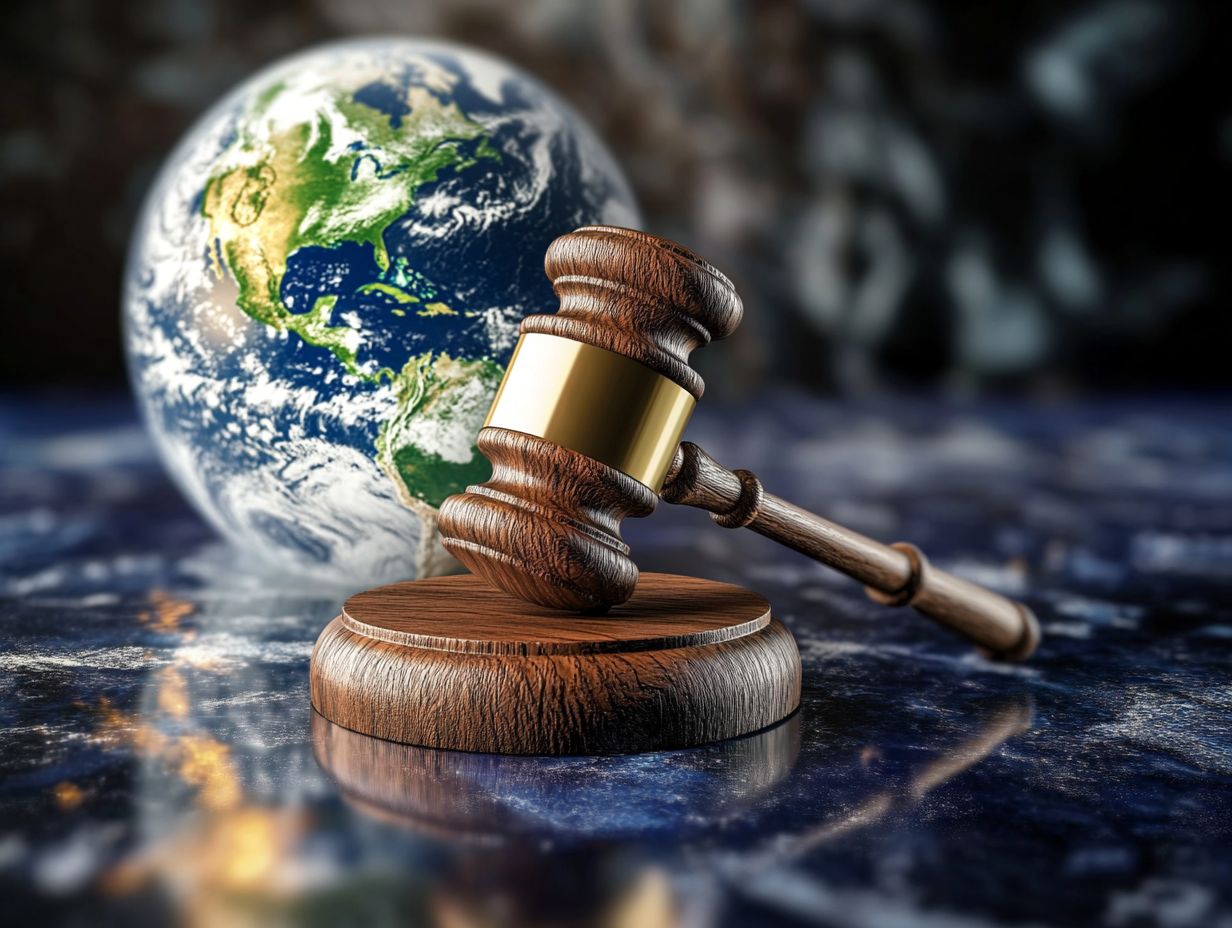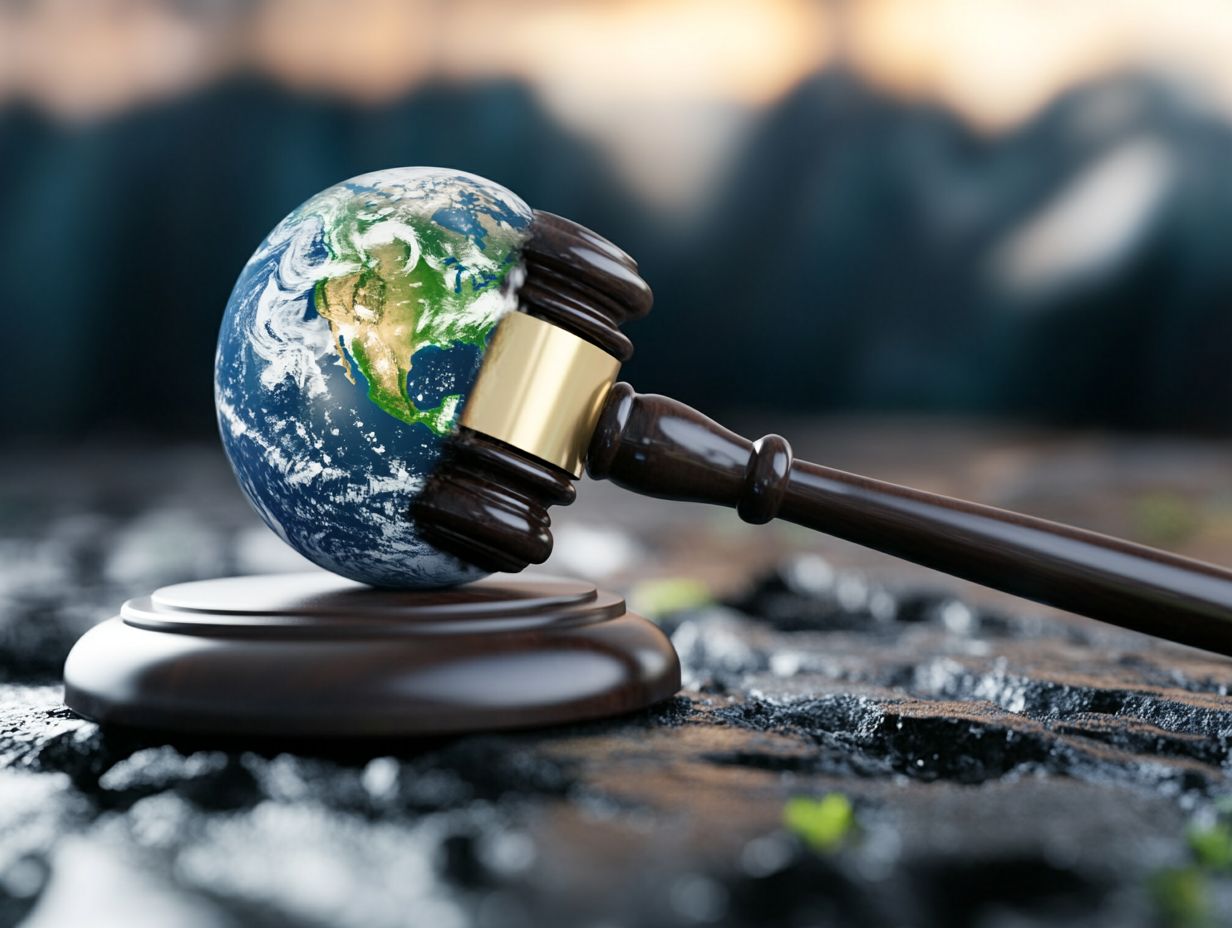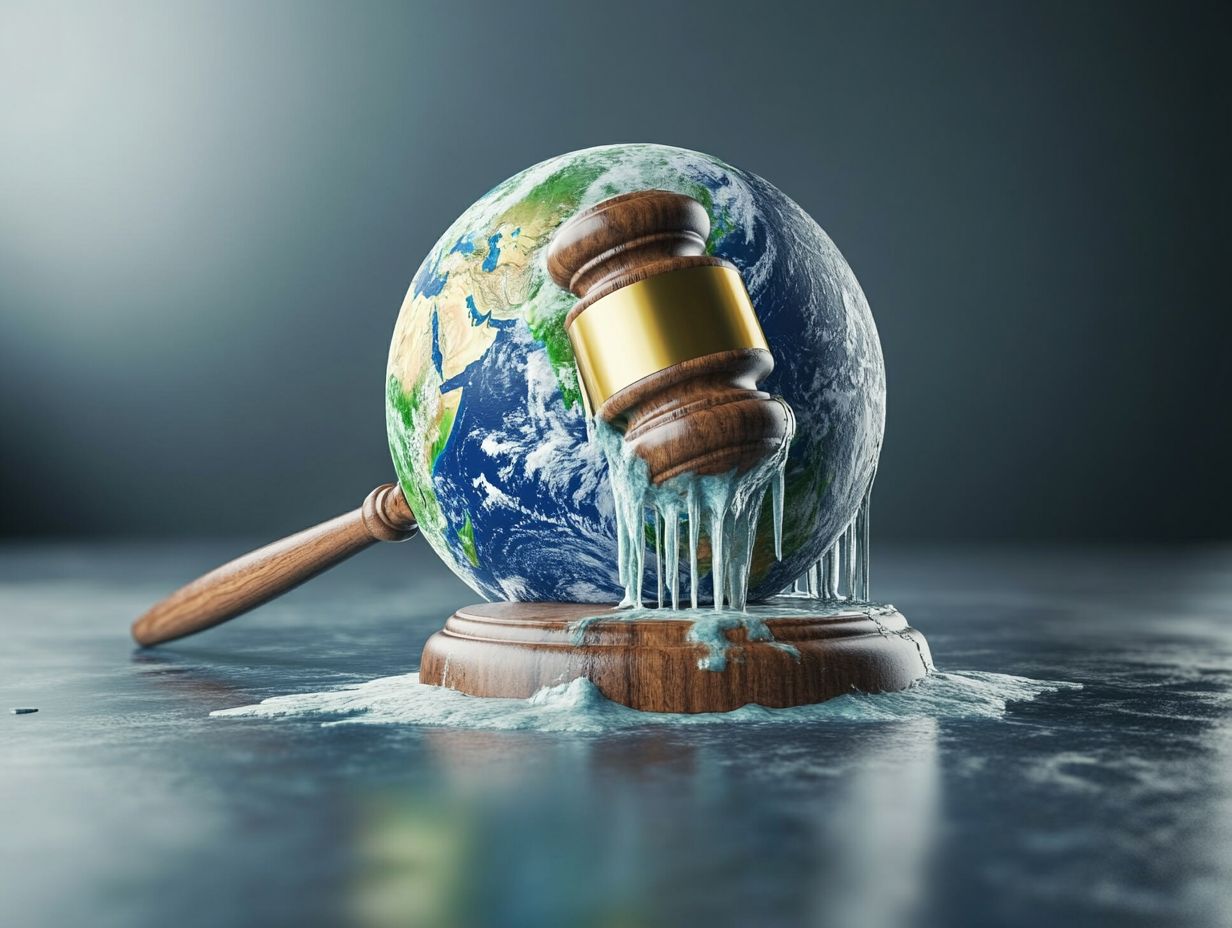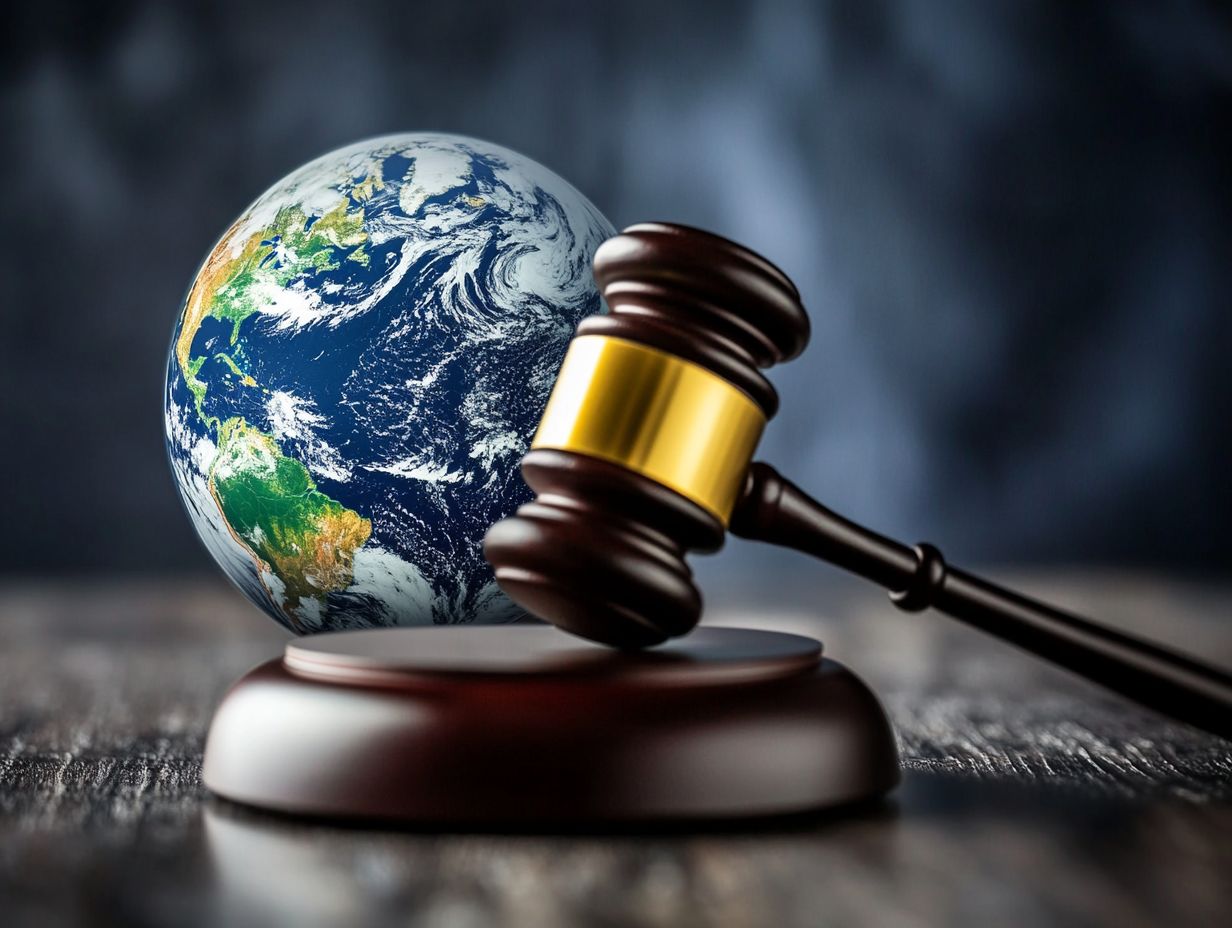The Intersection of IP Law and Climate Change
Dive into this article to discover how climate change is reshaping intellectual property (IP) law!
Intellectual property (IP) law is essential for fostering innovation and creativity. However, as climate change escalates, its significance is shifting in fascinating ways.
This article delves into the complexities of IP law, outlining its diverse types and protections while revealing unique challenges climate change presents that demand reform.
You will explore current legal battles and controversies where IP intertwines with environmental issues. Additionally, discover strategies to adapt IP protections for a sustainable future.
As you join this examination of a critical intersection, you ll uncover the pivotal role IP law can play in tackling climate change head-on.
Contents
- Key Takeaways:
- Understanding Intellectual Property Law
- The Impact of Climate Change on IP Law
- Current Cases and Controversies
- Navigating IP Protection in a Climate-Conscious World
- Future Outlook and Predictions
- Frequently Asked Questions
- 1. How does IP law intersect with climate change?
- 2. What are relevant IP rights related to climate change?
- 3. Can IP law be used to address climate change directly?
- 4. How can IP law help promote green innovation?
- 5. Is there any conflict between IP law and climate change initiatives?
- 6. What are current challenges at the intersection of IP law and climate change?
Key Takeaways:
- Climate change poses new challenges to IP law, affecting the protection and enforcement of intellectual property rights.
- Legal battles over climate change-related IP are increasing, highlighting the need for adapted IP laws and strategies.
- IP law plays a vital role in addressing climate change by incentivizing innovation and protecting the rights of creators and inventors in the pursuit of sustainable solutions.

Understanding Intellectual Property Law
The overview of intellectual property (IP) law encompasses a comprehensive array of legal frameworks crafted to safeguard the rights of creators and inventors while nurturing innovation and economic growth.
In an era increasingly centered on technological advancement and the shift toward climate neutrality, grasping IP law becomes paramount for stakeholders from governments to private enterprises and individuals alike.
Insights from thought leaders, such as Ms. Kathi Vidal, Under Secretary of Commerce, play a crucial role in guiding you through the intricate challenges of IP in today s swiftly changing landscape.
What is IP Law?
Intellectual property (IP) law encompasses a suite of legal rights enabling you to maintain exclusive control over your inventions, designs, and artistic creations. This framework not only protects your ingenuity but also nurtures an environment conducive to innovation.
Understanding this legal structure is essential for safeguarding your work, allowing you to reap the rewards of your labor without the looming threat of unauthorized use. IP law acts as a catalyst for societal progress, inspiring individuals like you to push the boundaries of creativity and technology.
Consider how:
- Patents shield your unique inventions,
- Trademarks preserve your brand identity,
- Copyrights uphold your rights as an author or artist.
By acknowledging and enforcing these various forms of intellectual property, society creates a vibrant ecosystem where your creativity and innovation can truly thrive.
Types of IP and Their Protections
The types of intellectual property (IP) and their protections encompass patents, trademarks, copyrights, and trade secrets each carefully crafted to safeguard your interests as a creator or innovator in your field.
Patents grant you exclusive rights to your inventions, allowing you to control how your innovations are used and distributed for a limited time. Trademarks shield the distinctive symbols, names, or slogans that set your products or services apart, ensuring your brand’s integrity remains intact.
Copyrights protect your original works of authorship, spanning literature, music, and art, enabling you to reap the rewards of your creative endeavors. Trade secrets, which include unique formulas, practices, and processes that remain confidential, offer you a competitive advantage.
Influential figures like Kathi Vidal are actively engaged in initiatives to bolster IP protection, advocating for stronger enforcement and education to help innovators like you fully grasp your rights and obligations.
Understanding these rights can empower you to innovate confidently.
The Impact of Climate Change on IP Law

Climate change is reshaping IP law. The need for innovative climate technologies challenges traditional intellectual property rights.
As the world confronts the climate crisis, understanding how IP intersects with sustainability efforts is vital. This knowledge is essential for industries aiming for carbon neutrality and compliance with international agreements like the Paris Agreement.
Challenges and Changes to IP Law
Challenges and changes to IP law are increasingly apparent as the demand for innovation rises, especially in light of global climate change needs that often conflict with existing frameworks.
The swift advancement of technologies designed to tackle environmental issues calls for a more flexible approach to IP rights. Current laws can stifle collaboration among innovators wishing to share resources and knowledge in the battle against climate challenges.
Many inventors may find themselves restricted from freely licensing their sustainable technologies due to inflexible models favoring exclusivity over accessibility.
To overcome these hurdles, legislative changes are essential. Establishing frameworks that promote open-source collaborations or fostering public-private partnerships could pave the way for a more sustainable and innovative environment equipped to combat climate change.
Current Cases and Controversies
Current IP law cases highlight the complex relationship between climate change and intellectual property rights, especially at the intersection of IP law and human rights.
This dynamic raises multifaceted questions regarding ownership, access, and the public good within the urgent pursuit of sustainability.
Legal Battles Over Climate Change and IP
Legal battles over climate change and IP are heating up as we navigate the complex landscape of legal rights to inventions while striving for effective solutions to environmental challenges.
These disputes frequently center around ownership and accessibility of essential technologies for combating climate change, including renewable energy innovations and carbon capture techniques.
Conflicts between major corporations regarding the licensing of green technologies highlight the delicate balance between fostering innovation and ensuring fair access.
The outcomes of these legal skirmishes significantly influence how swiftly new environmentally beneficial inventions reach the market.
As courts deliberate on the rights of inventors versus the pressing need for climate action, the repercussions extend beyond current stakeholders. These decisions set precedents that can obstruct or propel future innovations aimed at safeguarding our planet.

Solutions and strategies for IP protection in a changing climate are essential as we navigate the complex landscape of balancing inventors’ rights with the demand for sustainable practices that effectively tackle the climate crisis.
Adapting IP Law to Address Climate Change
Adapting IP law to address climate change is vital for ensuring legal frameworks propel innovation towards sustainable technologies and practices essential for tackling climate change.
A thorough review of existing IP regulations is needed to eliminate barriers that currently impede the development and dissemination of green technologies.
By introducing reforms that prioritize open access and collaboration, innovators can unite in pursuit of shared climate goals.
Incentives such as tax breaks and grants for environmentally friendly technologies could motivate businesses to embrace sustainable practices.
Increasing public investment in research and development can enhance these efforts, facilitating rapid advancements in climate innovation without the looming threat of restrictive legal constraints.
Future Outlook and Predictions
The future of IP law regarding climate change is evolving rapidly. Legal frameworks will focus more on sustainability and innovation.
The Role of IP Law in Addressing Climate Change
IP law is crucial for protecting your innovations. It paves the way for sustainable solutions to pressing environmental challenges.
By creating a legal framework that encourages sharing technologies, IP law fosters collaboration across sectors like agriculture and renewable energy. This approach enhances the exchange of innovative ideas and adapts existing technologies to the demands of a changing climate.
Align your efforts today with global sustainability goals. This will foster an environment where new solutions can thrive, amplifying their positive impact on the planet.
Frequently Asked Questions

1. How does IP law intersect with climate change?
IP law protects the rights of creators and innovators. It helps develop new technologies for green innovation.
Relevant rights include patents for renewable energy technologies and trademarks for eco-friendly products.
3. Can IP law be used to address climate change directly?
While IP law cannot directly fight climate change, it facilitates the development and spread of environmentally friendly technologies.
4. How can IP law help promote green innovation?
IP law incentivizes companies and individuals to invest in green technology by offering exclusive rights and protections. This drives competition and further innovation.
5. Is there any conflict between IP law and climate change initiatives?
Potential conflicts may arise where IP rights hinder the adoption of eco-friendly technologies. However, measures like compulsory licensing exist to balance these concerns.
6. What are current challenges at the intersection of IP law and climate change?
Challenges include finding a balance between promoting green innovation and ensuring access to affordable technologies for those affected by climate change. Addressing the misuse of IP rights and enforcing protections in international agreements are also key issues.






